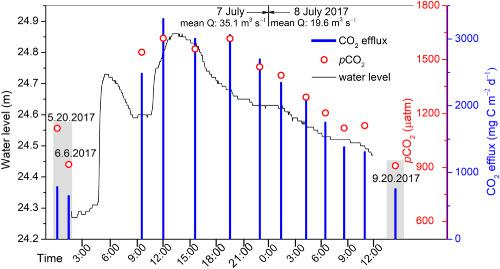当前位置:
X-MOL 学术
›
Earth Surf.Process. Land.
›
论文详情
Our official English website, www.x-mol.net, welcomes your feedback! (Note: you will need to create a separate account there.)
Riverine export of water, sediment and carbon during flood events in the arid to semi‐arid Wuding River on the Chinese Loess Plateau
Earth Surface Processes and Landforms ( IF 3.3 ) Pub Date : 2020-03-06 , DOI: 10.1002/esp.4845 Lishan Ran 1 , Xiankun Yang 2 , Mingyang Tian 2 , Hongyan Shi 3 , Shaoda Liu 4 , Ruihong Yu 3 , Yuanyuan Zhou 5
Earth Surface Processes and Landforms ( IF 3.3 ) Pub Date : 2020-03-06 , DOI: 10.1002/esp.4845 Lishan Ran 1 , Xiankun Yang 2 , Mingyang Tian 2 , Hongyan Shi 3 , Shaoda Liu 4 , Ruihong Yu 3 , Yuanyuan Zhou 5
Affiliation

|
Floods have become increasingly important in fluvial export of water, sediment and carbon (C). Using high‐frequency sampling, the export of water, sediment and C was examined in the Wuding River catchment on the Chinese Loess Plateau. With groundwater as an important contributor to runoff all year round, floods were relatively less important in the export of water. However, large floods were disproportionately important in exporting sediment and inorganic C (DIC) and organic C (DOC and POC). The three largest floods in each year transported 53.6–97.3 and 41.4–77% of the annual sediment and C fluxes, respectively. An extreme flood in 2017 alone contributed 94.6 and 73.1% of the annual sediment and C fluxes, respectively, in just 7 days, which included 20.3, 92.1 and 35.7% of the annual DOC, POC and DIC fluxes, respectively. A stable carbon isotope (δ13C) analysis of POC indicated that modern soils and C3 plants were its primary source. Furthermore, floods greatly accelerated CO2 degassing due to elevated gas transfer velocity, although stream water CO2 partial pressure (pCO2) exhibited a decreasing trend with flow discharge. Although these results illustrated that increasing runoff diluted pCO2, the timing and magnitude of floods were found to be critical in determining the response of pCO2 to flow dynamics. Low‐magnitude floods in the early wet season increased pCO2 because of enhanced organic matter input, while subsequent large floods caused a lower pCO2 due to greatly reduced organic matter supply. Finally, continuous monitoring of a complete flood event showed that the CO2 efflux during the flood (2348 ± 664 mg C m–2 day–1) was three times that under low‐flow conditions (808 ± 98 mg C m–2 day–1). Our study suggests that infrequent, heavy storm events, which are predicted to increase under climate change, will greatly alter the transport regimes of sediment and C. © 2020 John Wiley & Sons, Ltd.
中文翻译:

黄土高原干旱至半干旱武定河洪水灾害期间江河水,沉积物和碳的出口
洪水在水,沉积物和碳(C)的河流出口中变得越来越重要。利用高频采样,对黄土高原武定河流域的水,沉积物和碳的出口进行了检查。由于地下水是全年常年径流的重要因素,洪水在水的出口中的重要性相对较小。但是,大洪水在出口沉积物,无机碳(DIC)和有机碳(DOC和POC)中尤为重要。每年三大洪水分别输送了每年的沉积物和碳通量的53.6–97.3和41.4–77%。仅在2017年就发生了一次特大洪灾,仅在7天之内就分别贡献了年度沉积物和碳通量的94.6%和73.1%,其中分别包括年度DOC,POC和DIC年通量的20.3、92.1和35.7%。13 C)对POC的分析表明,现代土壤和C3植物是其主要来源。此外,尽管溪流水的CO 2分压(p CO 2)随着流量的增加而降低,但洪水由于提高的气体传输速度而大大加速了CO 2的脱气。尽管这些结果说明增加的径流稀释了p CO 2,但发现洪水的时间和大小对于确定p CO 2对流动动力学的响应至关重要。雨季初期的低水位洪水增加了p CO 2由于增加了有机质的投入,而随后的大洪水则由于大大减少了有机质的供应而导致了较低的p CO 2。最后,对整个洪水事件的连续监测表明,洪水期间的CO 2流出量(2348±664 mg C m –2 天–1)是低流量条件下(808±98 mg C m –2 天)的三倍。–1)。我们的研究表明,预计在气候变化下不经常发生的强风暴事件将极大地改变沉积物和C的传输方式。©2020 John Wiley&Sons,Ltd.
更新日期:2020-03-06
中文翻译:

黄土高原干旱至半干旱武定河洪水灾害期间江河水,沉积物和碳的出口
洪水在水,沉积物和碳(C)的河流出口中变得越来越重要。利用高频采样,对黄土高原武定河流域的水,沉积物和碳的出口进行了检查。由于地下水是全年常年径流的重要因素,洪水在水的出口中的重要性相对较小。但是,大洪水在出口沉积物,无机碳(DIC)和有机碳(DOC和POC)中尤为重要。每年三大洪水分别输送了每年的沉积物和碳通量的53.6–97.3和41.4–77%。仅在2017年就发生了一次特大洪灾,仅在7天之内就分别贡献了年度沉积物和碳通量的94.6%和73.1%,其中分别包括年度DOC,POC和DIC年通量的20.3、92.1和35.7%。13 C)对POC的分析表明,现代土壤和C3植物是其主要来源。此外,尽管溪流水的CO 2分压(p CO 2)随着流量的增加而降低,但洪水由于提高的气体传输速度而大大加速了CO 2的脱气。尽管这些结果说明增加的径流稀释了p CO 2,但发现洪水的时间和大小对于确定p CO 2对流动动力学的响应至关重要。雨季初期的低水位洪水增加了p CO 2由于增加了有机质的投入,而随后的大洪水则由于大大减少了有机质的供应而导致了较低的p CO 2。最后,对整个洪水事件的连续监测表明,洪水期间的CO 2流出量(2348±664 mg C m –2 天–1)是低流量条件下(808±98 mg C m –2 天)的三倍。–1)。我们的研究表明,预计在气候变化下不经常发生的强风暴事件将极大地改变沉积物和C的传输方式。©2020 John Wiley&Sons,Ltd.



























 京公网安备 11010802027423号
京公网安备 11010802027423号